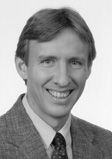

Todd Hubing,
Associate Editor
The Presidents Memorial Award provides scholarship money to promising young graduate students studying EMC-related fields. The President’s Memorial Award scholarships can only be awarded in years in which there are adequate resources available in the President’s Memorial Award Fund. This fund is entirely dependent upon private and corporate donations. Tax-deductible donations to the President’s Memorial Award Fund can be mailed to: Warren Kesselman All money contributed is used to provide scholarships. There are no management or overhead charges. The President’s Memorial Award Fund is independent of other IEEE accounts and cannot be used for any other purpose. |
Doublemint will probably be contacting Don Heirman and me after this year’s symposium in Washington D.C. Have you seen those commercials that feature twins doing fun things while chewing Doublemint gum? After I get my Don Heirman haircut, they’ll probably want to make a commercial showing Don and me playing golf, running on the beach or doing ESD tests.
As you may have heard, I volunteered to get my hair cut like Don Heirman’s if at least $10,000 is donated to the President’s Memorial Award fund before the August EMC symposium. The President’s Memorial Award is the Society’s highest award. Each year, it honors a prominent deceased member of the EMC Society by providing scholarship money to support the education of a promising young student studying EMC. This award is supported entirely by contributions. Without the help of people like you and me, this important program will cease to exist.
I’ve received lots of email from people telling me they plan to contribute. Even people I’ve never met tell me they can’t wait to see me with a Don Heirman haircut. The only person who’s expressed any reservations at all is my wife. She thinks Don’s hair looks pretty good on him, but she’s quick to point out that Don has more hair to work with. Ever since my hairline started receding, I’ve been using the longer hairs in the middle of my head to hide the hairless areas on either side. With a Don Heirman haircut, there’s no hiding anything. Nevertheless, I’m sure that when my wife sees me with my new haircut, the first words out of her mouth will be, “It looks great, Dear. I love it.” I know this because over the years I’ve learned that this is the only acceptable way to react when your spouse comes home with a new hairstyle.
Speaking of the August symposium, I’ve noticed that exhibitors at the symposium often give away small items with company logos. It occurred to me recently that hats would be really neat give-away items. Don’t you agree? I know that if I received a hat at the EMC symposium, I would want to wear it almost everywhere I went. This would be particularly true if it were a hat from a company that contributed to the President’s Memorial Award Fund. Maybe the hats could say, “I support the President’s Memorial Award!” Everyone would want a hat like that. Especially people who need to keep the Washington sun off the tops of their heads. Don and I could wear our hats when we make the Doublemint commercial. I hope I can learn to do an ESD test and chew gum at the same time.
David Dennis, chair of the Atlanta chapter, reports that they had a meeting on December 2, 1999. Their guest speaker was Mike Hopkins of KeyTek Instruments, and he delivered a presentation entitled “IEC Standards Update - October 1999: Changes to IEC Standards on ESD, EFT, Surge, PQF, RF Immunity and Emissions.” Mike gave a basic overview of the EMC standards relating to these topics and he held an interactive discussion with the meeting attendees on the possible changes or revisions to the standards. Through Mike’s firsthand involvement with the IEC Working Group responsible for development of basic EMC standards, he was able to provide valuable insight into what the future holds for these requirements and procedures.
Dr. Li Shufang reports that Prof. Gao Yougang, chair of the Beijing chapter, invited Mr. Elya Joffe, a Distinguished Lecturer of the IEEE EMC Society, to the Beijing University of Posts & Telecommunications. Mr. Joffe gave a brilliant two-part presentation on November 4th and 5th. The first part was titled, “Grounding Design in Printed Circuit Boards.” Mr. Joffe introduced the basics of grounding design followed by many practical application examples. The second part was titled, “High Speed Signal Traces as Transmission Lines in PCBs.” First Mr. Joffe proposed the idea of viewing power distribution networks as signal return paths. Then he discussed transmission line effects on PCBs and examples of typical transmission lines on PCBs as well as methods of controlling reflections. 52 researchers from universities, research institutes, and industries such as Beijing Univ. of Posts & Telecom., China Academy of Science, Shanghai Bell Telecommunication Company, Zhong-Xing Company, Hua-Wei Company among others were present. Over 20 IEEE members attended the research meeting. Mr. Joffe’s lecture was very much appreciated by all of those in attendance. When he finished his presentation, the audience burst into thunderous applause. After the presentation, a heated discussion took place to the benefit of everyone involved. Many of those in attendance suggested that such wonderful presentations sponsored by the IEEE EMC Society should be held more frequently.
John Clarke, chair of the Central New England chapter, reports that three meetings were held in the fall of 1999. The September meeting was a joint meeting with the North East Product Safety Society. Kefeng Liu, of EMC Test Systems in Austin, Texas, spoke on the subject of “EMC Chamber Design and Measurement.” The presentation ad- dressed fundamental parameters involved in designing a large indoor shielded EMC chamber capable of making 10-meter radiated EMI tests. Key com- ponents such as RF absorbers and ground plane properties were discussed. Measurement accuracy of various RF instruments used was also addressed. Precision measurement of antenna factors and chamber Normalized Site Attenuation were covered. The use of various broadband antennas, Geometry Specific Antenna Factors and Free-Space Antenna Factors were also discussed. There were 25 people in attendance.
The featured speaker at the November meeting was Dr. Mirko D. Matejic of the Foxboro Company in Foxboro, Massachusetts. Dr. Matejic gave a presentation titled, “EMC Test Laboratory Assessment.” On behalf of NVLAP and A2LA, Dr. Matejic has assessed over 100 EMC test laboratories. He discussed typical laboratories’ strengths and deficiencies identified during on-site assessments. A credible way to determine EMC product compliance with applicable standards is to test the product at a competent accredited laboratory. All deficiencies must be well documented and referenced to either IEC/ISO Guide 25 or relevant technical specifications. If all deficiencies are resolved, the assessor recommends laboratory accreditation.
The topic of the December meeting was “Antenna Behavior, Design and Use.” The speaker was Colin E. Brench of Compaq Computer Corporation in Maynard, Massachusetts. EMC Corpora- tion staff conducted a tour of their new 10-meter semi-anechoic chamber. The facility tour was arranged by Boris Shusterman, a Principal Compliance Engineer at EMC Corp. This was followed by the technical presentation. Many of the differences between test facilities can be traced to antenna issues. Understanding antenna behavior during real measurements, site attenuation measurements and calibration will largely explain discrepancies that result. The speaker discussed these issues and closed by describing the design of an antenna prepared for ANSI. There were 37 people in attendance at this meeting.
Derek Walton reports that the Chicago chapter continues to be busy. In December, 3-Com in Rolling Meadows was the venue for a presentation on signal integrity (SI) issues. Ray Lethental of 3-Com was the presenter, and Viewlogic provided an assortment of EMC/SI tools so that attendees could familiarize themselves with what can be simulated.
Election of the Chapter officers also took place at the December meeting. Each of the existing officers were reinstated, with the addition of three new positions. Clifford Kraft of Lucent Technologies has joined the program planning team while Carla Robinson of 3-Com and Frank Krozel of Electronic Instrument Associates have formed a new publicity team to help spread the news about our Chapter program.
The Chapter now has a formal website that is maintained by Frank Krozel. The location is: https://www.ewh.ieee.org/soc/ emcs/chicago/. Feel free to browse the site, and perhaps join us at an upcoming event. This is also where you will find the latest information on our Mini-Symposium scheduled for May 22-23, 2000.
Sufficient interest was generated at the Chapter meeting discussing the ACIL inter-laboratory comparison that the Chapter has decided to perform its own version using a comb generator. Several test facilities have offered to perform a test and share the results. If any Chapter would like to perform a similar activity and share their data, please alert Clifford Kraft or Derek Walton. Contact information is on the chapter website.
(Thanks to Bill Paschetag for submitting the following report on the activities of the Dallas chapter.)
The October meeting of the Dallas EMC Society was held on October 19th at KTL, Lewisville, Texas. The guest speaker was John Olivant, Vice President of Technical Services at KTL, who spoke on “Telecom Regulatory and Testing Issues.” Attendees were also given a tour of the KTL test facilities. There were 26 guests in attendance (12 IEEE members).
The November meeting of the Dallas EMC Society was held on November 15th, at Abbott Labs, Irving, Texas. The guest speaker was distinguished lecturer Don Heirman, Associate Director of the University of Oklahoma EMC Wireless Center, speaking on “Happenings at the University Center for the Study of Wireless EMC.” Attendees were given a tour of the Abbott EMC test facilities. There were 27 guests in attendance (12 IEEE members). Nomination of Officers for 2000-2001 for the Dallas EMC Society chapter was held during the November meeting. Gary Shimko (Marconni Communications) was nominated for Chair, Bob Queen (Abbott Laboratories) was nominated for Vice-Chair and Bill Paschetag (SpectraPoint Wireless) was nominated for Secretary-Treasurer.
No technical meeting of the Dallas EMC Society was held in December, but instead a holiday social was held on December 21st at Enchilada’s Restaurant in Dallas. Twelve people, including five guests, attended the social.
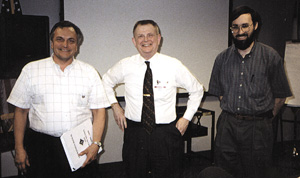 |
| Gary Shimko, Dallas EMC Chapter Vice Chair, Don Heirman, distinguished guest speaker at the November meeting and Mark Bushnell, Dallas EMC Chapter Chair. |
Dr. Frank Gronwald reports that the German EMC chapter encountered a very special highlight when the “International Symposium on EMC” was held on October 5-7 in Magdeburg, Germany. About 150 participants joined the meeting and listened to 75 presentations, related to 10 main topics and covering most aspects of EMC. It was a scientific treat for the German chapter to have international experts from the U.S., France, Sweden, and Russia present, among them Dr. C.E. Baum and Dr. F. Tesche. They stimulated a host of challenging discussions. In addition to the talks, two workshops on “European EMC standards” and “EMC Threats” were conducted. In particular, the last topic sparked curiosity and the interest of the local TV and national press, which reported on the meeting.
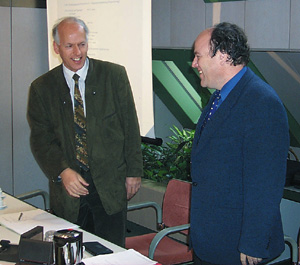 |
| First Fellow of the German EMC Society Chapter, Professor ter Haseborg (L), joined Chapter Chairman Professor Garbe at a recent chapter meeting. |
The strength of the EMC community was clearly demonstrated when a historic experiment of Otto-von-Guericke (1602-1686) was performed during the symposium banquet. 14 EMC experts were required to separate two evacuated Magdeburgian half spheres of 20-cm diameter, tightly held to each other by the surrounding air pressure.
The organization of the symposium had been put into the hands of Professors Juergen Nitsch and Guenter Wollenberg who just established the Institute for Fundamental Electrical Engineering and EMC at the University Magdeburg. Everybody agreed that they succeeded in not only assembling a meeting of high scientific value, but also in providing an enjoyable and relaxing atmosphere.
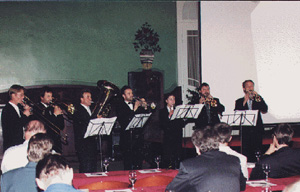 |
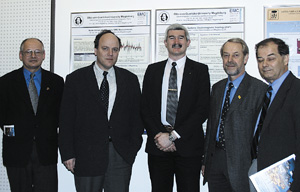 |
| Everyone enjoys listening to the fanfare composed by Dr. C. E. Baum at
the opening of the International Symposium on EMC in Magdeburg. |
Two Chapter Chairs and the organizers of the EMC lecture series at the University of Magdeburg join speaker Elya Joffe following his presentation. Shown from left are Zbigniew A. Styczynski, Heyno Garbe (German EMC Chapter Chair), Elya B. Joffe (Israeli Chapter Chair), Juergen Nitsch and Guenter Wollenberg. |
The 6th meeting of the German IEEE EMC Chapter took place on November 17 in Frankfurt. The main topics were the reports from the chair, from the “Numerical Field Calculation” Group and from the “Biological Effects” Group. The chairman, Professor Garbe, thanked the chapter members for their last year activities and presentations and congratulated Professor ter Haseborg on his appointment as the first Fellow in the German EMC Society. Altogether, Professor Garbe reported about 15 meetings in Berlin, Braunschweig, Hamburg and Magdeburg, which were organized by German IEEE members. He announced a presentation of Mr. Joffe dealing with “Transients and Electrical Overstress Protection in Electronic Systems.” In November 1999, there was a special issue of the Transactions on EMC, organized by the German Chapter. The German EMC Society was represented on two executive committee meetings and one chairman meeting by Professor Garbe. Mr. Mrozynski reported for the working group on “Numerical Field Calculation” which created 15 configurations and problems to benchmark different calculation tools. A complete list can be downloaded at https://www-tet.uni-paderborn.de. This benchmark catalog will also be part of a workshop at the IEEE EMC symposium in Washington, DC this year. The working group on “Biological Effects” was renamed “Human Security in Fields” to underline the electro-technical aspect. A new suggestion was the creation of a working group on “EMC and Defense-Devices” to help with the scientific interchange of information between civil and military developments. Professor Garbe reported also about a cooperation between the VDE and IEEE.
The German Chapter sponsored a very special event to start the new year. On January 12th, Distinguished Lecturer, Elya B. Joffe, who came all the way from Israel, contributed as a speaker to the regular series of technical meetings at the University of Magdeburg. The Chairman of the 2003 IEEE International Symposium on EMC in Tel-Aviv shared his impressive practical expertise and spoke on “Transients and Electrical Overstress Protection in Electronic Systems.” The audience of more than 30 participants was not only impressed by the two hour presentation, but also by the communication skills and enthusiasm of the distinguished guest. After the presentation, those present were invited to have some refreshing coffee, tasty cookies, and further discussion. Later, Mr. Joffe spontaneously gave two more colorful presentations in an accelerated mode. Besides the presentations, there was also time enough to tour the EMC facilities at the University of Magdeburg, in particular the reverberation chamber and the GTEM-cell. An interdisciplinary technology center, which will provide the home for a new anechoic chamber, is still under construction, but expected to be ready at the end of this year. The discussions in and outside the lecture hall not only conveyed a wealth of useful information but also further tightened the bond between the Israeli and German Chapters.
The Korea Chapter of the IEEE EMC Society hosted a workshop and exhibition called “EMC Korea ’99” with the cooperation of the Korea Electro- magnetic Engineering Society (KEES). The event was held at the Seoul Education and Culture Center on September 30 and October 1, 1999. 140 attendees and 17 exhibitors attended the workshop. Mr. Mark Montrose, Montrose Compliance Service, Inc. (USA) and Prof. Shuichi Nitta, Tokyo University of Agriculture and Technology in Japan opened the workshop with two one-hour invited talks. The topics of their presentations were “EMI and PCB Funda- mental Concepts and Design Tech- niques” and “The Practice and the Problems of Shielding by Metal Plates,” respectively. The invited talks were chaired by Korea Chapter Chair, Prof. Dong-Chul Park and another 11 talks were successively presented by Korean EMC engineers and professors during the two days. The talks were organized to introduce practical EMC techniques to engineers and students. Topics included “PCB design for EMC compliance,” “EMC considerations on semiconductor devices,” “EMI suppression experiences in home-appliance products,” “Electro- magnetic shielding and absorbing techniques,” and “Regulations on EM hazards.” A technical exhibition was also organized for the first time in Korea in the EMC area, and 17 booths were attended successfully. The Korea Chapter plans to hold this kind of technical workshop and exhibition annually.
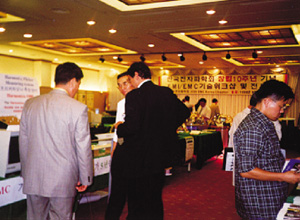 |
| Korea Chapter Chairman, Prof. Dong-Chul Park and speaker Mark Montrose pause in the exhibition hall to visit with Dr. Kyung-Chan Min at EMC Korea '99, hosted by the Korea EMC Chapter. |
The inaugural meeting of the Melbourne, Florida chapter was held on 2 December 1999. The chapter was officially formed on 5 October 1999, and will serve EMC engineers working in Central Florida. The meeting took place at the Indian River Brewing Company facilities in Melbourne, where the 18 attendees enjoyed pizza and cold drinks.
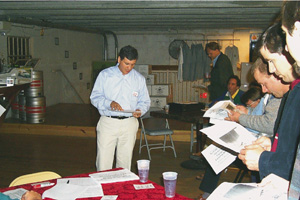 |
| Ed Kirchner discusses the integration of COTS equipment into the E-8C with other Central Florida EMC engineers. |
After Chapter Chair Bruce Crain welcomed everyone to the chapter and meeting, Ed Kirchner of Northrop Grumman presented the paper, “An EMC Design Approach for Integrating COTS Equipment into an Existing Military Platform.” This paper, which was also given at the 1999 IEEE International Symposium on EMC in Seattle, described Northrop Grumman’s experience in integrating COTS computing equipment into the E-8C Joint STARS aircraft. The paper generated an interesting group discussion about the growing use of COTS equipment and the various EMC challenges that result.
Attendees at this inaugural meeting were enthusiastic about the formation of the Melbourne chapter and we look forward to reporting our activities and plans in upcoming issues of “Chapter Chatter!”
(Thanks to Ray Adams, chair of the Los Angeles chapter, for submitting the following report.)
Looking back on 1999, the Los Angeles Chapter had a good year but not as good as in years past. This can be attributed to changes at our old meeting facility. The officers of the LA chapter looked high and low in the area for an affordable and acceptable new meeting location. We had two meetings at the Ramada Inn Hawthorne prior to the summer break and two after the break at our new location WEMS Electronics. The Ramada was no bargain and Vice-Chair Kaniaya Mahendra and WEMS’ John O’Brien came up with the WEMS location for our next two meetings. We had the following speakers in Y2K-1:
In April, Bill Whitlock of Jensen Transformers spoke on “Practical Applications of ’Grounding’ Home Theater and Stereo Systems.” This was a pleasant change from the usual “grounding” talks. It was actually something we could use at home! Our chapter has looked at “grounding” from many different perspectives over the years: spacecraft, equipment, facility, lightning, and safety. This was new and appreciated territory to cover.
In March, Dr. Jason Chai of the Aerospace Corporation spoke on “A Lightning Data Survey and Parameters in Retest Criteria for Spacecraft.” Dr. Chai’s presentation was an analysis of the various re-test criteria such as distance from launch site to lightning strike that had been used by three contractors. Depending upon the distance/amplitude criteria set by the contractor, they could unknowingly penalize themselves thus delaying their preparations for launch.
In September, Dr. Scott Bennett gave a presentation titled, “The Basic Source of EMI - And The Key to EMC.” Dr. Bennett used basic trigonmetry and algebra to visualize the complex integrations required in electromagnetics.
The October meeting featured Dr. Richard Briet, who spoke on “The Verification and Validation of the Theory of Lightning Propagation and Lightning Protection: What it Means to the User and to the Supplier of Lightning Protection Systems.” Dr. Briet’s presentation was very interesting as it questioned the validity of current lightning protection practices. He had some real interesting photos of lightning strikes that seemingly defy physics or explanation.
Now that we have a stable meeting location, we are in the early stages of planning a full lineup of speakers for 2000. We have Steve Jensen coming to talk to us in January on “EMC War Stories: Tales From The Trenches” and have several others tentatively lined up for subsequent meetings. Y2K has the potential to be an excellent year for the Los Angeles Chapter.
Benoit Nadeau, chair of the Montreal chapter reports that they had two meetings this past fall. The October meeting featured a talk on “Unusual and Hidden Forms of Electrostatic Discharge” by Mr. Douglas C. Smith of Auspex Systems. The November meeting featured a presentation by Dr. Kok-Swang Tan of Health Canada. The topic of this presentation was “Susceptibility of Medical Devices to Electromagnetic Interference.” Both presentations were very informative and well appreciated by the people who attended these meetings.
On another subject, the committee for organizing the 2001 IEEE EMC Symposium is busily preparing for the upcoming symposium in Montreal. The real work will begin following the Washington, DC Symposium this August.
Prof. Wen Xun Zhang, chair of Nanjing chapter, reports that the Nanjing chapter successfully completed its schedule of technical activities in 1999. A total of 29 technical events were organized at Nanjing and Shanghai.
Two IEEE Distinguished Lecturer Programs were sponsored by the Nanjing chapter and also the Beijing chapter. Dr. Mark Gouker of MIT gave three presentations in May-June; Prof. Nader Engheta of the University of Pennsylvania also gave presentations on three topics in October and November. In addition, four experts from abroad were invited individually. Prof. O.P. Gandhi (USA) spoke on the topic of bio-electromagnetics. Dr. Y. H. Gu (USA) gave an interesting lecture on smart antennas. Dr. M. Zhang (Germany) spoke to the chapter on EM simulators. Dr. Z. X. Shen (Singapore) gave a presentation on modal expansion techniques. There was a pronounced academic environment present during the discussion between these speakers and the Chinese members and colleagues in attendance.
The chapter also co-sponsored a National Symposium on Antennas and chaired its technical program committee. The proceedings published included 310 pages (66 papers). Two local workshops were held on prediction models for mobile propagation and EM software, respectively. Ten normal lectures on a wide range of topics were also arranged during 1999.
The accumulated attendance for the above activities was over 1600 (~1.5 times of that in 1998). About one third of the attendees were IEEE members. In addition to the technical meetings, a “Chapter Members Meeting” and sightseeing program were held for the membership in Shanghai. The number of chapter members has increased from 95 to over 100 during the past year.
The Oregon and SW Washington EMC Chapter closed 1999 with a Christmas social. This was held at the “Amadeaus at the Fernwood” restaurant. (See pictures.) The event was held at this former mansion atop a hill overlooking the Willamette Valley: the perfect setting for socializing and getting away from those ever-present RF fields!
|
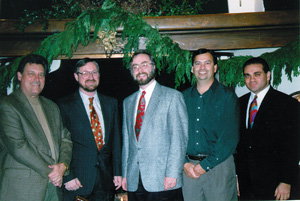 |
| Nicole Lockart-Rayner, the renowned guest pianist, provided entertainment at the
Oregon and SW Washington Chapter Holiday Social. Great job Nicole! |
Oregon and SW Washington Chapter Officers present at the chapter's 1999 EMC Holiday Social are (L-R) Jerry Page of Northwest EMC, Ed Blankenship of Hewlett-Packard, and Charles Tohlen, Henry Benitez and Ali Elmi, all of Tektronix. |
In October, Doug Smith turned the “static” subject of ESD into an electrifying educational and comedic adventure. Doug filled the house with over 40 people in attendance. The 12 large pizzas were just enough!
Henry Benitez, chapter chairman and also EMCS BoD Awards Chairman, took advantage of the occasion to present Doug with a belated award for his contributions to experiments and demonstrations at past EMC symposia. Also in attendance was Daryl Gerke, Phoenix chapter officer, who received an award for his contributions to the success of the ’99 Arizona EMC Colloquium.
 |
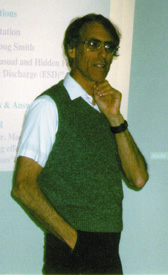 |
| Daryl Gerke (L) is presented with an award for his contributions to the
success of the 1999 Phoenix Chapter Colloquium by Oregon and SW Washington Chapter Chairman and EMC Society Awards Chairman Henry Benitez. |
Doug Smith, speaker at the Oregon and SW Washington Chapter meeting in October, is caught in a pensive moment. Is he pondering the real meaning of ESD? |
Mr. Ed Blankenship of Hewlett-Packard was a last minute guest speaker for our November chapter meeting. Ed did a fabulous job presenting his topic “Lloyd’s Mirror - Interferometer and Comparison to Free Space, a.k.a. OATS.”
The Oregon and SW Washington EMC Chapter has been committed to providing quality activities to its membership each and every month. With this goal in mind, the planned ’00 program is just as impressive. Planned are talks from Mike Windler on C63.4 antenna and site calibration, Werner Schaefer on measurement instrumentation, Maqsood Mohd on the effects of lightning on equipment and humans, Elya Joffe on EMC troubleshooting, and Doug Smith’s famous workshop on building high frequency probes. Continued speaker coordination with the Seattle chapter has been very rewarding.
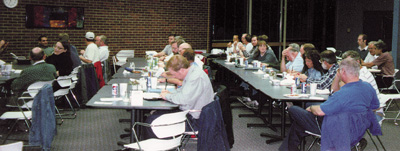 |
| It was a studious audience preparing itself for the October Oregon and SW Washington Chapter presentation by Doug Smith of Auspex Systems in Santa Clara, California. |
Happy New Millennium!
Harry Gaul, secretary/treasurer of the Phoenix chapter reports that their last meeting was held on November 4, 1999. Charlie Swiontek of Power-One (Camarillo, CA) entertained the audience with a well-received talk on “How to Meet the EC Harmonic Requirements.” Most electronic systems create a certain amount of harmonic distortion to the AC powerlines. This harmonic distortion may be small on a product by product basis, but these harmonic effects become a very real problem when the entire AC power grid is considered. Charlie discussed the new legislation in Europe which will enforce the requirements of the EN61000-3-2 as of January 1, 2001, wherein all new electronic products sold in Europe with power requirements greater than 65 watts will be required to meet a new power line quality standard.
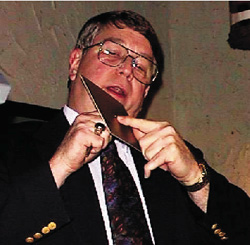 |
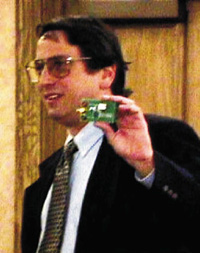 |
| Bob Dockey, EMC Engineering Group Manager for Hewlett Packard
(Vancouver, WA), displays his circuit board that he used for investigating the phenomena of common mode radiation induced by return currents in a ground plane. |
Mark Montrose displays the PCB that he used to research the effect of
capacitor placement. |
There is some confusion in the U.S. concerning whether the lower limit is 50 watts, 65 watts, or 75 watts. Charlie’s response to this was that the Europeans generally design in power factor correction because it adds value to the product. They don’t understand why Americans typically try to avoid meeting requirements by using a strict legalistic interpretation of applicability. Thus, it doesn’t matter to European manufacturers if the lower limit of applicability is 50 watts, 65 watts, or 75 watts. They will design and test their equipment for compliance with EN61000-3-2 regardless of the lower limit.
Charlie outlined various approaches possible for meeting the new legislative requirements and the costs associated with these approaches. The attendees learned that in some cases there may be no cost delta to add power factor correction (PFC) if done early in the design phase. Typically, the cost of a power supply will be higher by 10% when PFC is added. The usual approach is to add a second switcher, which operates on the AC side to smooth the current drawn over the entire sine wave cycle. Charlie also shared some “low budget” approaches where a 50-Hz resonant filter is built from two inductors with capacitors connected across each one. The cost delta of this approach is maybe 7 or 8% but it is usually used on low power products drawing less than 200 watts.
The Phoenix chapter was very fortunate to find such a dynamic speaker as Charlie. Other chapters may wish to have Charlie talk at their upcoming meetings. A copy of his PowerPoint presentation is available at https://www.ewh. ieee.org/r6/phoenix/phoenixemc/powerone.ppt.
At the December meeting, Bob Dockey, an IEEE EMC Society Distinguished Lecturer, enlightened the Phoenix chapter about how a “good ground plane” on a circuit board can still produce common mode radiation, similar to a dipole. There were 25 attendees, 60% of which were IEEE members.
In 1993, Bob Dockey began investigating various means to reduce common mode radiated emissions from printed circuit boards (PCBs). During the course of Bob’s research, he attached wires to opposite sides of a ground plane to simulate the attachment of shielded cables. He found that the radiated emissions tended to increase upon adding the wires due to the common mode current flowing along these wires. The emissions were caused by a small voltage gradient in the ground plane.
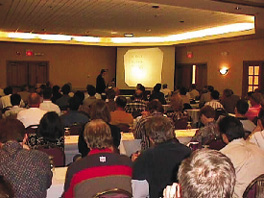 |
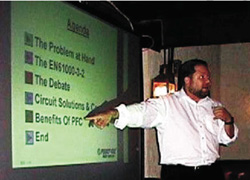 |
|
| Over 100 engineers attended the Phoenix Chapter's January meeting with PCB expert and IEEE Distinguished Lecturer, Mark Montrose. | Charlie Swiontek of Power-One talks about the benefits of Power Factor
Correction in consumer electronics. |
Research performed by Bob showed that the emissions can be reduced by decreasing the distance between the signal trace and the ground plane, by providing additional low-impedance paths for the signal current, and by placing an image plane above the PCB and connecting it to the ground plane around its periphery. Since Hewlett-Packard manufactures computer accessories such as ink-jet printers in great quantities, all of their EMC design rules for PCBs concentrate on minimal parts and inexpensive manufacturing costs. For example, HP strives to use PCBs that have no more than four layers. With a four-layer board, Bob recommends that the two inner layers be ground planes with a 62-mil separation. The two outer layers are for signal traces and they are separated from the ground layers by only seven mils of pre-preg. Ground vias connect the two ground planes wherever a signal via penetrates the ground planes. Also, guard traces are routed along side any high speed traces to reduce common mode radiation. In response to a question from the audience, Bob explained that they don’t place the ground planes on the outside layers of the PCB due to manufacturing problems during the soldering process.
At the January meeting, the Phoenix chapter hosted a three-hour workshop with the EMC Society’s Distinguished Lecturer, Mark Montrose. A total of 109 people attended this very popular event with 39 of them being IEEE members.
The workshop focused on designing printed circuit boards (PCBs) correctly from the start. According to Mark, “We’re going to get the job done by using design rules. Let the others analyze it to death with Maxwell’s equations solvers.”
The attendees learned that the purpose of an autorouter is to maximize emissions, thereby ensuring job security for EMC Engineers. Mark outlined several important steps to successfully laying out a PCB:
1. Identify the “high threat” signals, which include reset, clock, audio, analog, video, high-speed digital and RF.
2. Manually route these signals to keep them short, direct, and separate from other high threat signals.
3. Protect these traces with the “protect” feature of the routing program.
4. Finally, allow the autorouter to route the remaining signals.
Mark also provided details on segmenting power and ground planes with moats and bridges to provide isolation for digital, analog, and I/O circuitry.
The workshop concluded with a special presentation of Mark’s IEEE paper titled “Why Decoupling Capacitors Radiate.” The results of his research showed that capacitor placement on a PCB is not critical, provided that each device and each decoupling capacitor has its respective VCC and GND pins tied directly to the power and ground planes with vias.
The Phoenix Chapter is sincerely grateful to Mark for sharing his expert knowledge on designing and laying out PCBs.
(Thanks to Lyle Luttrell, chair of the Rocky Mountain chapter, for submitting the following report.)
The Rocky Mountain chapter kicked off its fall program on September 28 with a highly amusing program “How to Design Digital Systems to Fail FCC & CISPR (in 20 easy steps),” presented by Daryl Gerke of Kimmel Gerke Associates, Ltd. 38 chapter members and guests enjoyed pizza sponsored by Criterion Technology then rolled along with Daryl for an interactive hour evening program. Starting with the advantages of “Design for Failure” (save component costs, gain management visibility and career mobility), Daryl provided RMC members with 20 easy to remember rules in three key design areas of components and circuit boards, cables and connectors and enclosures. Funda- mentals included the keys to a strong transmitter and a good antenna. Daryl provided special tips on techniques, elaborating on using fastest components available, locating clock and I/O lines together, using long leads on caps, and providing slots in enclosures. He included secrets on how to ensure failure even when forced to use EMC control measures such as shielded cables, bypass caps or line filters. During the presentation, several chapter members offered enhancements to the techniques that product designers had demonstrated at their companies, which will remain anonymous. Daryl concluded the light-hearted look at EMC problems with the most important rule: never ask for help or advice.
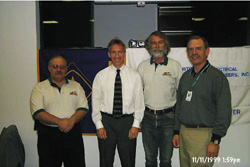 |
| Todd Hubing enjoyed visiting with the Rocky Mountain Chapter officers following his presentation. Shown from left are Charles Grasso (Vice-Chair), Todd Hubing, Bob Reinert (Secretary) and Lyle Luttrell (Chairman). |
The October 14 meeting featured Richard Charbonneau and Charles Grasso of StorageTek presenting “Embedded Capacitance - The Next Step in PWB Design.” 21 members attended the evening session. The presentation started somewhat uniquely with Charles Grasso moderating an interactive discussion with the audience. The interactive discussion centered on some decoupling engineering dogma. The presentation then moved to a discussion of the physics of power bus noise and an analysis of decoupling capacitor performance. The second part, presented by Rick Charbonneau, reviewed the details of the embedded capacitance project including; project members and mission statement, goals and objectives, the discovery process, test vehicle design, material considerations, electrical and qualification testing, modeling, deliverables, and timeline for the project. Part three, presented by Charles Grasso, reviewed some swept frequency response data taken on some of the PWB materials. A downloadable copy of the presentation is available at the chapter website.
On November 11, the chapter had another blockbuster turn out of 54 people to listen to Dr. Todd Hubing from the University of Missouri, Rolla discuss “PWB Power Structures - Theory and Design.” The need for good, low impedance power distribution is vital to the performance of today’s high-speed computing. It need not be said a great deal of lore is also involved especially in the area of decoupling. Following a pizza lunch, the meeting kicked off with Rick Charbonneau giving the attendees a brief overview of the NCMS Embedded Capacitance project. Dr. Hubing then presented a 3-hour tutorial that covered the theoretical aspects of power bus design and the seemingly contradictory nature of EMC engineers who might favor a lossy system and signal integrity engineers that demand a very low impedance distribution. Dr. Hubing also went over some of the performance data taken at the UMR EMC laboratory and finally presented some design guidelines. A downloadable copy of the presentation is also available at the Chapter website.
The Rocky Mountain chapter web site is regularly updated with information on past and future programs with links to other sites of interest for EMC engineers. The meeting program schedule and downloads of recent meeting presentations are available on our web site at https://www.ewh.ieee.org/r5/ denver/rockymountainemc/.
In October, the Seattle EMC chapter welcomed Doug Smith of Auspex Systems who responded to popular demand by presenting “Unusual Forms of ESD.” That plastic bag of change that Doug carries around sure is getting a lot of mileage these days!
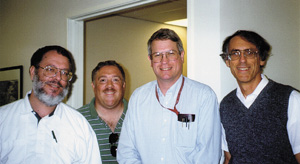 |
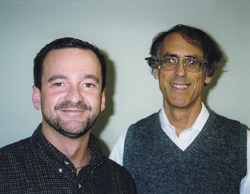 |
|
| Intel showed up in force at the October Seattle EMC Chapter meeting.
That's Leo Heiland, Mike Wyman and Chapter Chairman Ghery Pettit (L-R) all of Intel. |
Joel Lachance of Microsoft (L) enjoyed the presentation by Doug Smith of Auspex at the October Seattle EMC Chapter meeting. |
Doug began his presentation by stating the obvious: probably the main requirement a customer has for a piece of equipment is that it works. It can pass all of the IEC, CISPR, FCC, etc. tests, but if it does not work reliably, the customer will be unhappy. His entertaining talk covered some unusual and hidden forms of ESD that have caused many field problems for a number of companies and even government agencies. These forms of ESD are not described in any standard and can cause problems even if the equipment passes CE requirements. These hidden forms of ESD can result in hundreds of hidden ESD events per minute with bandwidths to 20 GHz and beyond. It is not possible to prevent them by trying to control the environment (floor wax, wrist straps, etc.). Demonstrations of these ESD effects were shown - hence the plastic bag of change - and some general case histories were discussed. Many of the case histories were very entertaining (at least to those not originally involved in the problem) and helped keep the talk on the light side. Upcoming standards activity that addressed ESD were discussed to round out the presentation.
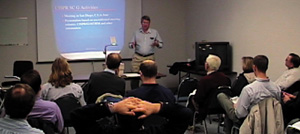 |
| Seattle Chapter Chairman Ghery Pettit did double-duty at the November chapter meeting. He chaired the meeting AND was the dynamic speaker! He's shown presenting his "CISPR Update" material before an attentive audience. |
At the November chapter meeting, Chairman Ghery Pettit was the local hero who filled in at the last minute for the originally scheduled speaker. Ghery rose to the occasion and presented an update on CISPR SC G proposed changes to CISPR Publication 22 and other documents. He addressed such topics as frequency range extension, ITE containing radio transmitters or receivers, limits over 1 GHz, user installation testing and ferrite clamps and tubes on radiated test sites, EMC requirements for multimedia equipment and EMC requirements for power line communication equipment. Ghery’s unscheduled presentation was a surprise “hit.” In the parking lot following the presentation, several chapter members were overheard to say, “Why haven’t we asked him to speak before?” and “Boy, was he a good speaker!” Everyone present was most appreciative of Ghery’s pitch hitting as speaker for the evening.
(Thanks to Kimball Williams for submitting the following report.)
 |
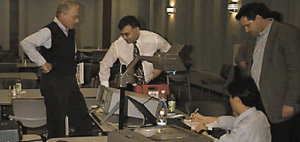 |
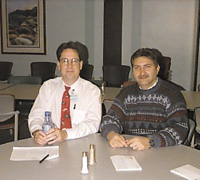 |
| Jim Muccioli of X2Y Attenuators spoke to a full house at
the November meeting of the Southeastern Michigan Chapter. |
Following the meeting, several Chapter members witnessed a
live demonstration of the material Mr. Muccioli presented. |
Vice Chair Scott Lytle (on the left) presided at the event, and spent some time catching up on events with Ray Sasinowski, (on the right), the founder of the Southeastern Michigan Chapter. |
The Wednesday, November 17, 1999 gathering of the Southeastern Michigan EMC chapter featured a lecture by James Muccioli of X2Y Attenuators discussing “Techniques for DC Automotive Motor Noise Suppression and Filtering of Common Mode and Differential Mode Noise.” The lecture was held at 6 pm with refreshments and conversation beginning at 5:45 pm. 41 engineers and technicians attended the meeting from as far away as Holland, Michigan (i.e., the other side of the state!).
The lecture employed a live demonstration of the phenomenon. (Those of us that work constantly with electronic instrumentation can appreciate the tendency of such equipment to make us aware of here-to-fore undiscovered ’features’ when we least expect it). All the demonstrations were coaxed into full function and clearly showed the characteristics of noisy motors and of filter performance (both good and bad). By the time he was through, everyone was interested in the possibilities represented by an integrated, balanced filter structure. After the formal presentation, Jim and several members of the audience discussed the subject material in greater detail.